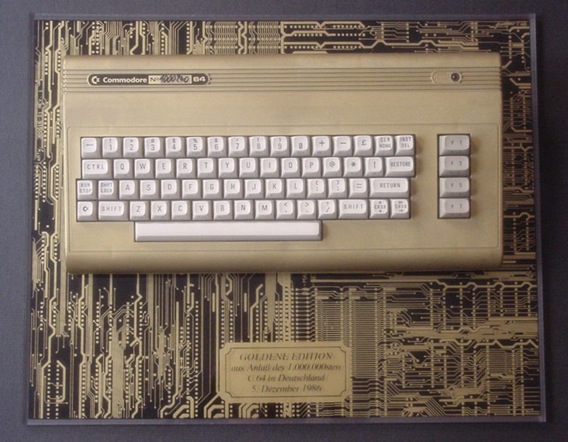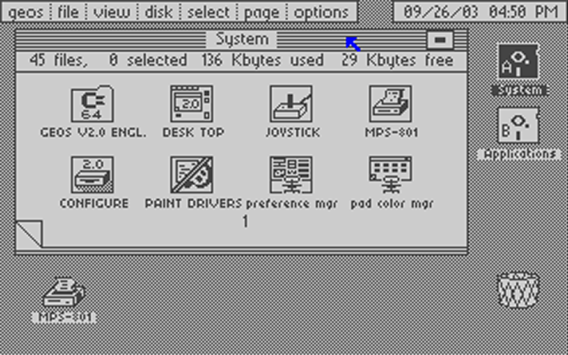Roughly 30 years ago - somewhere in august 1982 - a powerful new 8-bit computer was released to the largely unsuspecting public. This computer would change the world, introducing millions of people to a new hobby, tool, or even job!
It went on to become the best selling computer model of all time, shattering the previously held record about 17 times!

Above: A golden Commodore 64, celebrating one million Commodore 64s sold in Germany (1986).
The computer I'm talking about can, obviously*, only be the Commodore 64. A computer which was hugely significant in my own life and led to me choosing to be in IT rather than chemistry or history. Such an important piece of technology reaching 30 years is worthy of a celebration!
The Commodore 64 was quite advanced for its time and featured an array of custom chips aiding it in graphics, sound and input/output. It also had a large memory capacity and was expandable with disk drives, printers, tape drives and more. For more information on what made it tick here are its technical specifications.
Technical specifications for the Commodore 64:
For comparison: my current PC has 131000x as much memory, a processor that is about 12800x as fast (4 cores at 3.4GHz), a sound system with just about unlimited voices, a graphics card which supports a resolution that is 32x as high and features - literally - a million times as many colours. It can also do impressive 3D graphics, play youtube movies and emulate several C64's all at once.
And yet... There are plenty of days where I find myself preferring my C64!
Games, games, games!
While largely remembered for its amazing (and indeed, huge) catalogue of games, the Commodore 64 was capable of much more than just delivering solid entertainment with great graphics and superlative sounds.
Some of the more famous games for the Commodore 64 include Summer Games, Winter Games, Turrican I & II, Katakis/Denaris, The Great Giana Sisters, The Last Ninja I, II and III, Uridium, Paradroid, Archon, Lords of Midnight, Mayhem in Monsterland, etc.
The list - quite literally - goes on and on!
Business use!

Above: The GEOS operating system, a mouse based GUI for the Commodore 64.
Many a small business used the Commodore 64 in its time, due to it being cheap yet powerful. It featured a lot more memory than most other machines at the time and thanks to it being a large success, there where plenty of add ons to help make the most of your machine for business.
These add ons included extra memory, disk-drives, printers, cartridges, etc. Software for businesses included GEOS, Multiplan and a variety of primitive word-processors and custom business specific software.
The demo scene
Naturally, the computer was used not just for games and business. Its abilities meant large groups of people tried to push it to its graphical and sonic edges, thus the machine played a key role in starting the demo-scene**. Amazingly, demos for the little old Commodore 64 are still being produced today!
Some of the finer demos available include Edge of Disgrace (as seen above, it currently is the highest rated demo on the Commodore Scene Database), Deus ex Machina and Andropolis. In addition, I was personally rather impressed by the conversions of Desert Dream (originally for the Amiga) and Second Reality (originally for the PC) to the Commodore 64.
Be sure to watch those as well!
An enduring classic!
Today, the Commodore 64 enjoys popularity in the retro computer scene and is still used to play games, run GEOS and make demos. A marvellous achievement for a computer created by a former typewriter company and designed in about six weeks***!
Happy Birthday, Commodore 64!
On to the glorious next 30 years!
For more info on the above topics, check out the following sites:
Want to play some games, try GEOS or watch some demos but don't have a Commodore 64 lying about?
Have no fear! There is more than just YouTube. You can also use a Commodore 64 emulator and see for yourself what all the fuss is about!
To emulate the Commodore 64, check out the following:
*) Well, this is a site about Commodore computers ;)
**) The demo scene was most likely not started on the Commodore 64 (display hacks and the like go way back into the 1950s at least), but it's huge popularity meant that spreading demos and attracting new talent to make demos was much easier. It therefore played a huge role into popularising the scene.
***) Source: Commodore, a company on the edge (ISBN 978-0-9738649-6-0). Note that this does not include the time designing the custom chips, just taking all of them and making it into a computer. Ordinarily, that process takes months.
But apparently, this can change if your boss is Jack Tramiel!
It went on to become the best selling computer model of all time, shattering the previously held record about 17 times!

Above: A golden Commodore 64, celebrating one million Commodore 64s sold in Germany (1986).
The computer I'm talking about can, obviously*, only be the Commodore 64. A computer which was hugely significant in my own life and led to me choosing to be in IT rather than chemistry or history. Such an important piece of technology reaching 30 years is worthy of a celebration!
The Commodore 64 was quite advanced for its time and featured an array of custom chips aiding it in graphics, sound and input/output. It also had a large memory capacity and was expandable with disk drives, printers, tape drives and more. For more information on what made it tick here are its technical specifications.
Technical specifications for the Commodore 64:
- Slightly under 1MHz processing speed provided by the MOS6510 (a 6502 based CPU)
- Video courtesy of the VIC-II, which gives it a 40x25 text mode, a 160x200 and a 320x200 bitmap mode. It has 8 hardware sprites (which can be reused) and a 16 colour fixed palette. The sprites and colours are available in all modes (there is no dedicated monochrome mode, or a mode with, say, just 4 colours).
- Sound is provided by the legendary SID chip and features 3 independent voices, ADSR envelope, multiple waveforms and 16 volume levels
- 65536 bytes (64KB) of RAM memory, plus 1024 half-bytes (nybles) colour RAM memory
- 20480 bytes (20KB) of ROM memory (storing BASIC, KERNAL and character data)
- Microsoft Basic V2.0, featuring 38911 BASIC bytes free
- 5 1/4 inch diskette & audio tape IO
- Cartridge port
- All for under $600! (launch price August 1982: $595 US)
For comparison: my current PC has 131000x as much memory, a processor that is about 12800x as fast (4 cores at 3.4GHz), a sound system with just about unlimited voices, a graphics card which supports a resolution that is 32x as high and features - literally - a million times as many colours. It can also do impressive 3D graphics, play youtube movies and emulate several C64's all at once.
And yet... There are plenty of days where I find myself preferring my C64!
Games, games, games!
While largely remembered for its amazing (and indeed, huge) catalogue of games, the Commodore 64 was capable of much more than just delivering solid entertainment with great graphics and superlative sounds.
Some of the more famous games for the Commodore 64 include Summer Games, Winter Games, Turrican I & II, Katakis/Denaris, The Great Giana Sisters, The Last Ninja I, II and III, Uridium, Paradroid, Archon, Lords of Midnight, Mayhem in Monsterland, etc.
The list - quite literally - goes on and on!
Business use!

Above: The GEOS operating system, a mouse based GUI for the Commodore 64.
Many a small business used the Commodore 64 in its time, due to it being cheap yet powerful. It featured a lot more memory than most other machines at the time and thanks to it being a large success, there where plenty of add ons to help make the most of your machine for business.
These add ons included extra memory, disk-drives, printers, cartridges, etc. Software for businesses included GEOS, Multiplan and a variety of primitive word-processors and custom business specific software.
The demo scene
Naturally, the computer was used not just for games and business. Its abilities meant large groups of people tried to push it to its graphical and sonic edges, thus the machine played a key role in starting the demo-scene**. Amazingly, demos for the little old Commodore 64 are still being produced today!
Some of the finer demos available include Edge of Disgrace (as seen above, it currently is the highest rated demo on the Commodore Scene Database), Deus ex Machina and Andropolis. In addition, I was personally rather impressed by the conversions of Desert Dream (originally for the Amiga) and Second Reality (originally for the PC) to the Commodore 64.
Be sure to watch those as well!
An enduring classic!
Today, the Commodore 64 enjoys popularity in the retro computer scene and is still used to play games, run GEOS and make demos. A marvellous achievement for a computer created by a former typewriter company and designed in about six weeks***!
Happy Birthday, Commodore 64!
On to the glorious next 30 years!
For more info on the above topics, check out the following sites:
- For information on the Commodore 64 itself, visit the C64 wikipedia article or read more of the articles available on this site (including this one!)
- For a list of just about every game, go to Gamebase 64
- For game reviews and cover scans, visit Lemon 64
- For more about GEOS, try the zimmers.net GEOS page which holds GEOS programs, the GEOS FAQ and more or try the GEOS wikipedia page
- For just about all demos available ever and news about new demos and the C64 demo scene, visit the Commodore Scene Database (CSDb)
- To chat about the Commodore 64, go to the ever lovely Lemon 64 forums
- Interested in new game releases for the C64? Go to Psytronik Software and RGCD where you can buy new software for your C64 or C64 emulator.
Want to play some games, try GEOS or watch some demos but don't have a Commodore 64 lying about?
Have no fear! There is more than just YouTube. You can also use a Commodore 64 emulator and see for yourself what all the fuss is about!
To emulate the Commodore 64, check out the following:
- The best free emulator is called VICE and can be found at sourceforge. This site has all you need to relive (or try for the first time) the Commodore magic!
- There are PC, Mac OS X and Linux versions of the emulator available
- Windows users will want the 'MS-Windows 32bit (Pentium-optimized)' version
- Mac users will want the native 'Cocoa UI' version
- And Linux users... Will probably want the source code version!
*) Well, this is a site about Commodore computers ;)
**) The demo scene was most likely not started on the Commodore 64 (display hacks and the like go way back into the 1950s at least), but it's huge popularity meant that spreading demos and attracting new talent to make demos was much easier. It therefore played a huge role into popularising the scene.
***) Source: Commodore, a company on the edge (ISBN 978-0-9738649-6-0). Note that this does not include the time designing the custom chips, just taking all of them and making it into a computer. Ordinarily, that process takes months.
But apparently, this can change if your boss is Jack Tramiel!